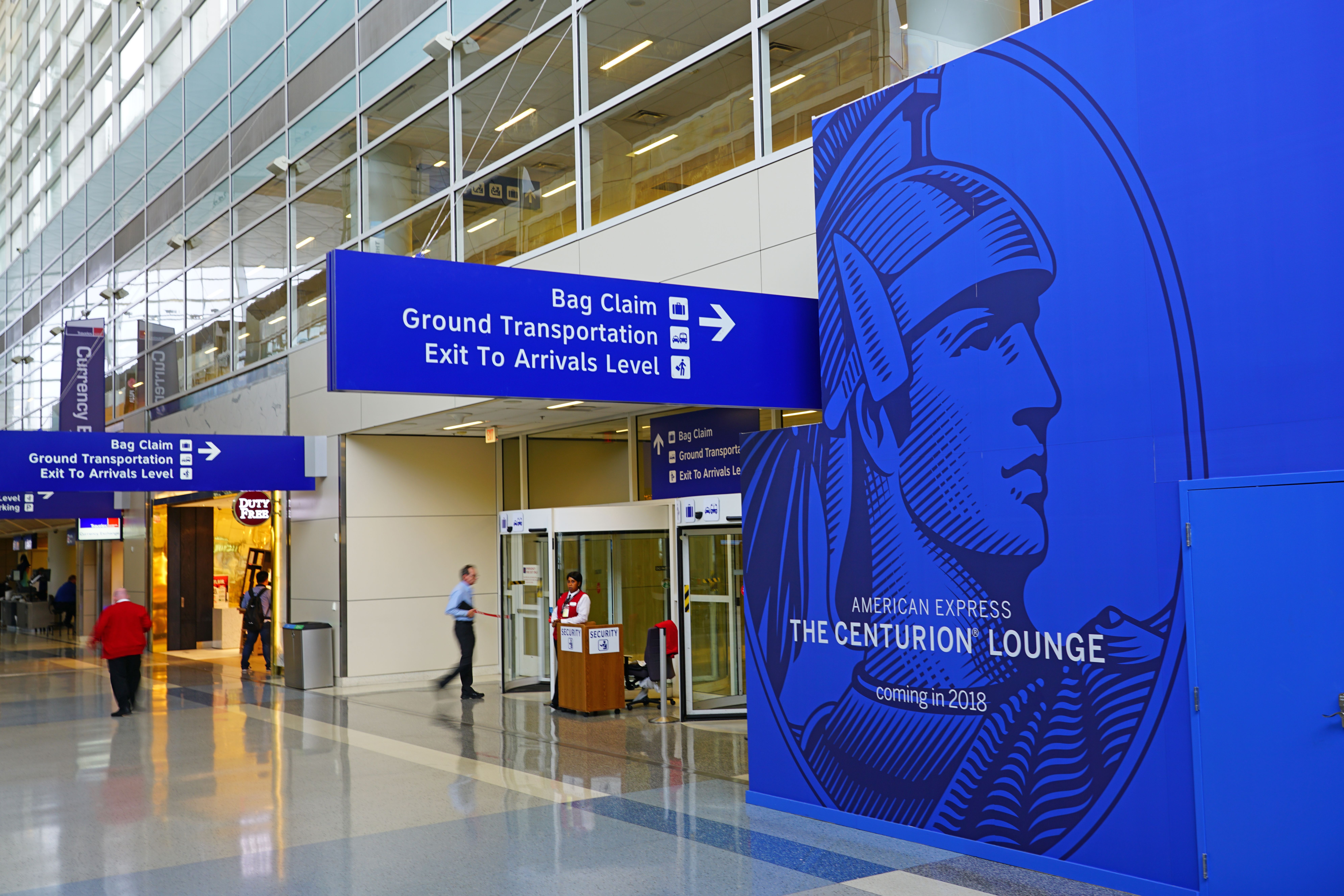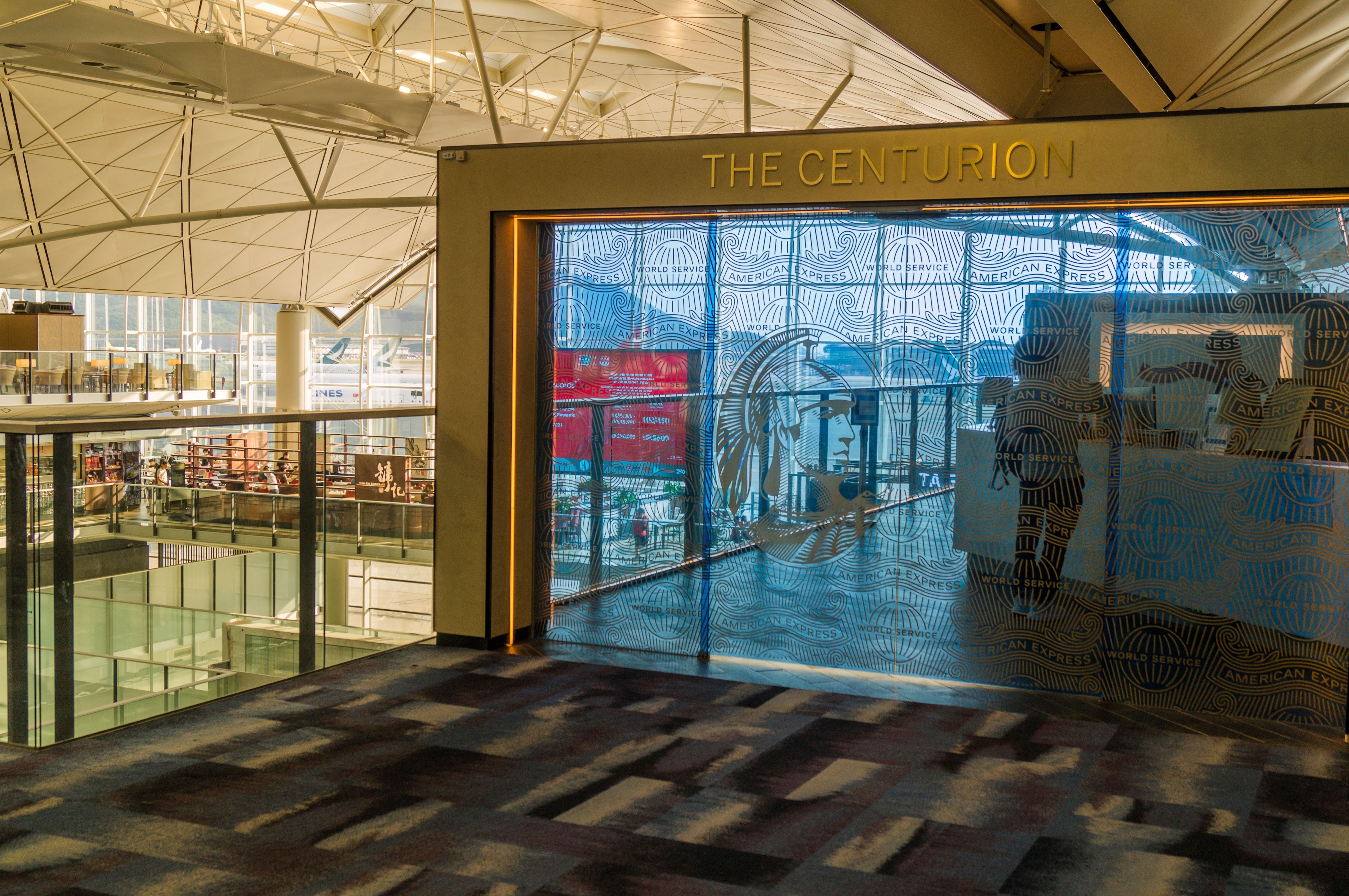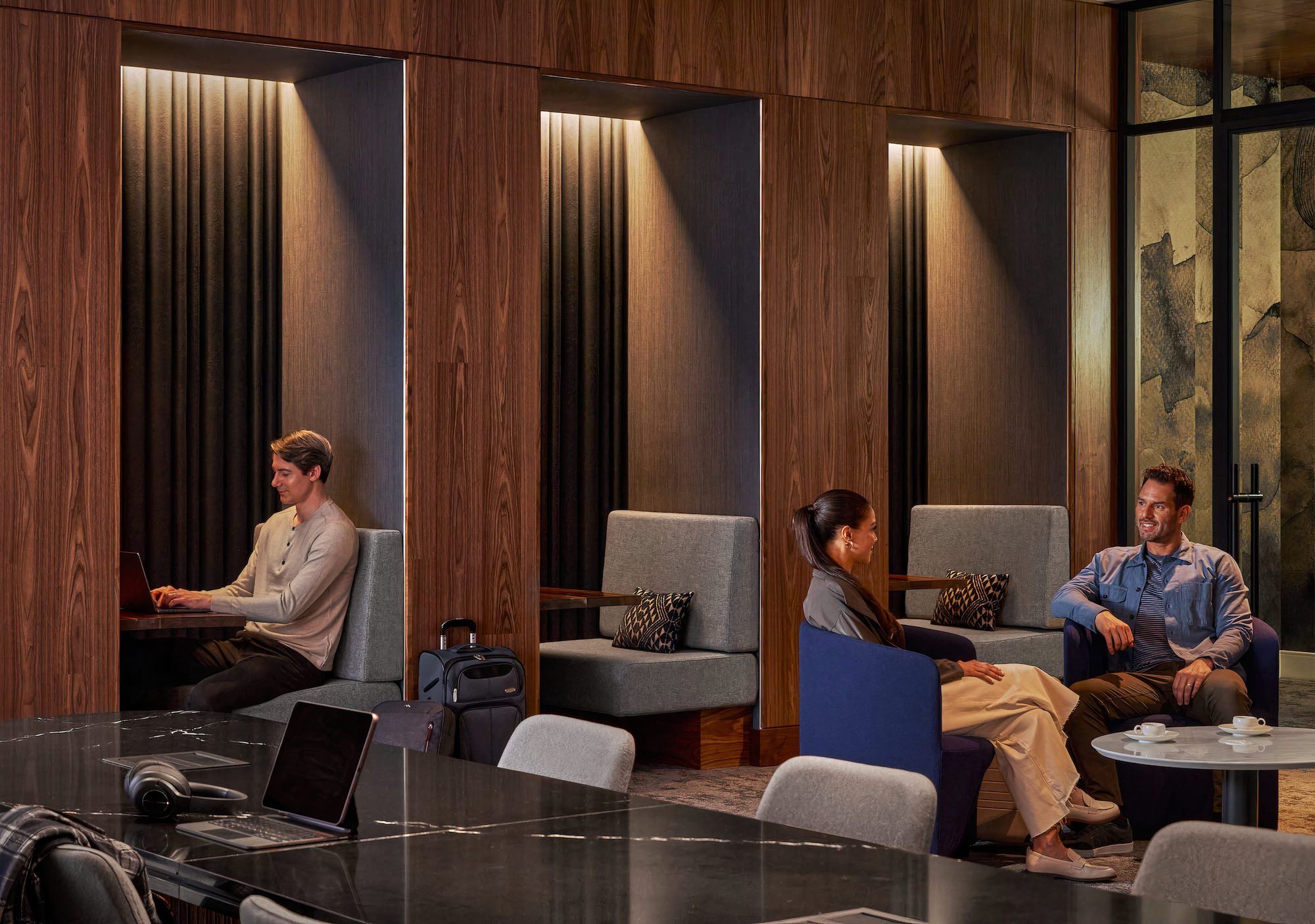The American Express Centurion Lounge is one of the premier airport lounge networks in the world. There are 26 lounges globally, with 15 of those being located in the United States. These are the most exclusive lounges offered to American Express cardholders, and as such, these are some of the highest quality lounges you’ll find at an airport.
American Express opened its first Centurion Lounge in 2013, at  Harry Reid International Airport (LAS ), known then as McCarran International Airport. It was the first credit card provider to open its own exclusive brand of airport lounges, and the list continues to grow. American Express markets itself as an upscale lifestyle brand, so the network of Centurion lounges is key to maintaining this image and cementing American Express as the world’s most premium credit card brand.
Harry Reid International Airport (LAS ), known then as McCarran International Airport. It was the first credit card provider to open its own exclusive brand of airport lounges, and the list continues to grow. American Express markets itself as an upscale lifestyle brand, so the network of Centurion lounges is key to maintaining this image and cementing American Express as the world’s most premium credit card brand.
How To Get Into The Centurion Lounges
Named after American Express’s flagship invitation-only credit card, the Centurion Lounges can be found at 15 US airports and 11 airports abroad, for a total of 26. The American Express Platinum, Business Platinum, Corporate Platinum, and, of course, the famed Centurion Card, grant access to the Centurion lounge. Visitors must have a boarding pass for a same-day departure with a confirmed seat, essentially barring passengers traveling on standby.
Additionally, American Express grants Centurion Lounge access to Delta SkyMiles Reserve and Delta SkyMiles Reserve Business cardholders. ![]() Delta Air Lines’ cardholders must be traveling on a same-day ticket on a Delta-marketed or Delta-operated flight booked with the American Express card. At the entrance, guests need to provide their boarding pass, a valid credit card, and a government-issued photo ID. Most locations only admit passengers within three hours of departure time.
Delta Air Lines’ cardholders must be traveling on a same-day ticket on a Delta-marketed or Delta-operated flight booked with the American Express card. At the entrance, guests need to provide their boarding pass, a valid credit card, and a government-issued photo ID. Most locations only admit passengers within three hours of departure time.
Most passengers are not permitted to bring complimentary guests except for children under the age of two. However, Corporate Platinum cardholders are permitted to bring two guests free of charge to Centurion lounges in the US, London, and Hong Kong. In comparison, Centurion cardholders are entitled to bring two complimentary guests to all lounges. All other passengers must pay $50 for guests over the age of 18 and $30 for minors.
Where To Find The Centurion Lounges
The American Express Centurion Lounges can be found in nine countries across the world. The majority of lounges are located in the US, which is American Express’ largest market. The remaining eight nations that host at least one Centurion Lounge are primarily home to major business hubs where American Express’ customers frequently travel to, or leisure destinations where AMEX cardholders frequent.
Of the eight nations outside the US that feature a Centurion Lounge, three have a Centurion Lounge at two airports. Australia, India, and Mexico are notable examples, with Australia having Centurion Lounges at Melbourne Airport and Sydney Kingsford Smith Airport, India featuring Centurion Lounges in Delhi Indira Gandhi International Airport and Mumbai Chhatrapati Shivaji Maharaja International Airport, and Mexico having Centurion Lounges at Mexico City and Monterrey.
|
Country |
American Express Centurion Lounge Locations |
|---|---|
|
Argentina |
Buenos Aires Ministro Pistarini International Airport (EZE) |
|
Australia |
Melbourne Airport (MEL), Sydney Kingsford Smith Airport (SYD) |
|
Hong Kong |
Hong Kong International Airport (HKG) |
|
India |
Delhi Indira Gandhi International Airport (DEL), Mumbai Chhatrapati Shivaji Maharaja International Airport (BOM) |
|
Japan |
Haneda Airport (HND) |
|
Mexico |
Mexico City International Airport (MEX), Monterrey International Airport (MTY) |
|
Sweden |
Stockholm Arlanda Airport (ARN) |
|
United Kingdom |
London Heathrow Airport (LHR) |
|
United States |
Charlotte Douglas International Airport (CLT), Dallas/Fort Worth International Airport (DFW), Denver International Airport (DEN), Hartsfield-Jackson Atlanta International Airport (ATL), Houston George Bush Intercontinental Airport (IAH), Harry Reid International Airport (LAS), Los Angeles International Airport (LAX), Miami International Airport (MIA), John F. Kennedy International Airport (JFK), LaGuardia Airport (LGA), Philadelphia International Airport (PHL), Phoenix Sky Harbor International Airport (PHX), Seattle-Tacoma International Airport (SEA), San Francisco International Airport (SFO), Ronald Reagan Washington National Airport (DCA) |
American Express also operates Centurion Lounges in Hong Kong, London-Heathrow, Tokyo-Haneda, Stockholm, and Buenos Aires. Furthermore, American Express operates 15 Centurion Lounges in the United States, located in Charlotte, DFW, Denver, Houston-Intercontinental, Las Vegas, LAX, Miami, JFK, LaGuardia, Philadelphia, Phoenix, Seattle, SFO, and Washington-National. AMEX has recently opened its newest lounge in Atlanta, and this may be its best lounge yet.
The Largest Centurion Lounge Ever Built
The Centurion Lounge at Hartsfield-Jackson Atlanta International Airport first opened in 2024. This is the newest Centurion Lounge to have been opened in the world, and it is also the largest lounge that AMEX has opened yet. It’s nearly 26,000 square feet, double the size of its lounge at Dallas/Fort Worth Airport. As Atlanta continues to hold the position of the world’s busiest airport, this size will be necessary to accommodate the high volume of passengers.
Some Centurion Lounges are known for being crowded, so the extra space will certainly be appreciated. Inside, passengers can expect a modern design with high ceilings and massive, floor-to-ceiling windows to maximize natural light. Natural woods and greenery dominate the interior. There are ample seating options, and the lounge offers numerous amenities in distinct areas, catering to a wide variety of passenger needs.
|
Atlanta Concourse E Lounges |
|---|
|
American Express Centurion Lounge |
|
Delta Sky Club |
|
Minute Suites |
The new Centurion Lounge can be found in Atlanta’s Concourse E near Gate E11. It’s open daily from 06:00 to 23:00, and eligible customers are permitted to enter within three hours of their scheduled departure time. As previously mentioned, AMEX Platinum cardholders and those holding a business or corporate version of the Platinum card are granted access to the lounge, along with Delta SkyMiles Reserve and Reserve Business cardholders.
A Dining Experience A Cut Above The Rest
The buffet in the lounge is intended to be more than an area to grab food, but rather, a reflection of Atlanta’s vibrant restaurant scene. American Express partnered with local chef Dehorah VanTrece to develop a rotating seasonal menu, blending familiar Southern flavors with international influences. The menu changes throughout the year to provide passengers with fresh, new options each time they visit.
Additionally, AMEX has invested heavily in its beverage offering. It employs Jim Meehan as the exclusive mixologist for the beverage menu at the Atlanta Centurion Lounge, as well as all other Centurion Lounges. The menu focuses on craft cocktails developed by Meehan, along with a curated wine list and a collection of locally sourced beers. It’s a focal point in the lounge, intended to invite passengers for refreshments before their flight.
As a whole, the Centurion Lounge’s dining area evokes freshness and activity. The layout of the dining area invites passengers to stop by for either a quick snack or a full sit-down meal, while the bar section provides a vibrant place for passengers to refresh and unwind prior to their flight. AMEX has also invested heavily in its staffing to ensure high-quality service and to keep the lounge as clean as possible.
The Technology And Amenities In The Lounge
While some older airport lounges have minimal connectivity options, the Centurion Lounge at  Hartsfield-Jackson Atlanta International Airport (ATL) is fully equipped with a wide range of connectivity and productivity tools. Naturally, the lounge does offer high-speed WiFi, but passengers also receive access to private work stations and conference rooms. Furthermore, almost every seat in the lounge comes with a power port, while soundproof phone rooms allow for phone calls to be made with minimal background noise.
Hartsfield-Jackson Atlanta International Airport (ATL) is fully equipped with a wide range of connectivity and productivity tools. Naturally, the lounge does offer high-speed WiFi, but passengers also receive access to private work stations and conference rooms. Furthermore, almost every seat in the lounge comes with a power port, while soundproof phone rooms allow for phone calls to be made with minimal background noise.
Throughout the lounge, passengers will find a wide variety of amenities. A wellness area offers a shower suite, a spa treatment room, and napping pods. These are particularly beneficial for transiting passengers. Printing and scanning services allow travelers to essentially bring their office to the airport, while those enjoying the relaxation amenities help reduce the fatigue of traveling, particularly beneficial for transiting passengers departing on or arriving from a long-haul flight.
American Express has created a lounge that caters to the needs of every traveler. It is as much a working area as it is a relaxation space, and several of the amenities provided are typically only seen in most airlines’ flagship lounges, such as the DeltaOne lounge or United’s Polaris lounges. This further differentiates American Express and helps cement its market position as the premium credit card provider in the United States.
Rundown Of The AMEX Lounge In Atlanta
The American Express Centurion Lounge is not just the best in AMEX’s lounge network, but it’s arguably one of the best lounges in the entire United States. It essentially competes with the DeltaOne lounges or United’s Polaris lounge network, offering a wide list of amenities contained in a massive 26,000 square feet space. It’s also been developed with all of the latest technological advancements, a notable benefit over other, older Centurion Lounges.
With its scale, extensive dining options, it addresses almost everything that a passenger could desire. Furthermore, its location in the world’s busiest airport aids in spreading awareness. While this is the newest lounge in AMEX’s network, the interior design still wows guests, while the extensive amenities ensure that passengers will have every reason to revisit it. The result is that this creates a positive perception of the Centurion Lounge network and American Express as a brand.
AMEX is preparing to open a brand new Centurion Lounge later in 2025 at Salt Lake City International Airport(SLC). Furthermore, renovations at the lounge at San Francisco International Airport are ongoing, while a new lounge is expected to open at Newark Liberty International Airport (EWR) in 2026. With new locations being added and ongoing renovations to an existing lounge, American Express will continue to improve the quality of these lounges as it continues to evolve the experience that it offers.








